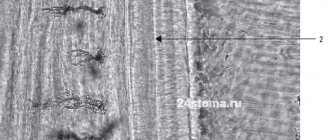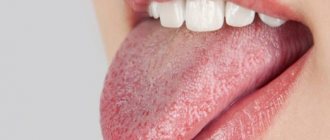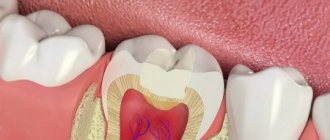Treatment of hypersensitivity of teeth with the drug “Dentin-sealing liquid”
Increased tooth sensitivity brings a lot of discomfort. The lesion may affect one or all teeth at once. The enamel becomes sensitive to hot and cold water, sour, sweet. Even just cool air when inhaling can cause pain. The dentists of our clinic will help you carry out high-quality diagnostics and prescribe effective treatment, regardless of the cause of this problem.
Treatment may include a whole range of measures, such as: adjustments to oral care, recommendations on how and with what to rinse teeth, treatment of the crowns of teeth with a special gel, advice on using a certain toothpaste, etc. For deeper carious lesions or cracks, it may be necessary to treat the tooth at the site of enamel damage with a filling.
In many cases, the drug “Dentin-sealing liquid” shows an excellent effect. It helps restore hard tooth tissues and prevents the development of caries. Recommended as a cushioning material when installing ceramic and other types of fillings. It has powerful antibacterial properties, as it contains copper ions. The bactericidal property makes it possible to maintain the sterility of dentin and enamel under restoration for a long time.
The drug has received many positive reviews from dentists around the world.
The sealing liquid consists of two bottles with different compositions. They are used as follows:
- the surface or cavity of the cleaned tooth (stump) is degreased and dried;
- apply composition No. 1;
- excess product is removed with a swab and dried if necessary;
- apply composition No. 2 (shake thoroughly before application);
- Next, a filling is applied.
Composition No. 2 contains a lot of calcium, which “seals” dentin, replacing damaged tooth enamel. Our clinic actively uses this drug in treatment. We will help you restore your teeth and restore the ability to eat sweet, sour, and cold foods without discomfort. Make an appointment with our specialists right now! Contacts are on the website.
Dentin sealing liquid 5ml + 5ml
Dentin sealing liquid is a preparation for deep fluoridation. Humanchemie, Germany
Prevention of caries. An effective means of preventing secondary caries and relieving dentin hypersensitivity is Dentin-sealing liquid. After preparing and washing the tooth cavity, liquids No. 1 (magnesium fluoride silicate with copper and calcium ions) and No. 2 (suspension of highly dispersed calcium hydroxide) are applied to its walls sequentially at intervals of 0.5-1 minutes. As a result of this extremely simple procedure, a plug of silicic acid gel containing microcrystals of copper fluoride, magnesium and calcium is formed in the dentinal tubules. The substance that makes up the cork is thixotropic, that is, capable of restoring its structure after mechanical stress. Thixotropic substances include thick suspensions, gels, pastes, and thick lubricants. The length of the plug is 5-10 microns, that is, approximately 2-3 orders of magnitude less than the length of the tubule itself. Over a long period, the contents of the dentinal tubules remain intact. If only a thin bridge remains between the dentin and the pulp, liquid No. 2 should be applied first, then liquid No. 1, and then liquid No. 2 again. This will avoid penetration into the pulp of even a minimal amount of liquid No. 1, which has a pH in the acidic range, as well as fluoride macrocrystals that have not yet completely collapsed. The main difference between Dentin-sealing liquid and Tifenfluoride is the higher content of copper ions. It is thanks to copper ions, which have a powerful bactericidal effect, that the sterility of enamel and dentin (and therefore pulp) under restorations is ensured. High concentrations of fluoride ions in the preparation (about 100 mg/l) have an additional bactericidal effect. The gel-like substance formed by the dentin-sealing liquid contains hydroxyl ions, therefore it helps to relieve inflammation in the pulp and stimulates the formation of secondary dentin. As experimental and clinical studies have shown, the size of the resulting plug is quite sufficient for reliable and hermetically sealed protection of dentin and pulp from harmful chemical agents during etching, application of adhesives, hardening of restoration materials, and from physical influences. The gel-like plug is relatively dense, but as a thixotropic substance it retains some ability to slide along the walls of the tubules under mechanical stress. Due to this, when etching or treating the tooth cavity with adhesives, the plug moves slightly inside the tubules, ensuring penetration of the applied materials to a sufficient depth while fully maintaining the retention of the filling material. Dentin sealant liquid is non-toxic and biocompatible with soft tissue. It should be used when restoring teeth using any types of restoration materials, for treating the tooth stump when installing temporary and permanent dentures.
Ensuring the sterility of dentin under restorations has become particularly important in recent years due to the spread in dentistry of the principles of the so-called Minimum Intervention in the formation of cavities. However, economical removal of dentin, which allows for maximum preservation of tooth tissue, also increases the risk of insufficient cleaning of it from bacterial contamination. It is quite obvious that isolating microbes from the oral environment by hermetically filling the tooth cavity with restorative material does not significantly reduce the risk of developing caries under the filling. Many surviving colonies of microorganisms can easily do without nutrients from the oral cavity, since the food product for them is the dentin itself with its organic components. This is convincingly demonstrated by the results of studies by Mayer et al. Deep dentinal caries was found under 176 of 180 composite fillings (without marginal signs of caries) removed with the consent of the patients. The microflora of carious dentin differed from the microbial composition of dental plaque and was closer to the microflora of infected root canals with a predominance of anaerobic and facultative anaerobic gram-negative rods. It should be noted that caries was also found under amalgam fillings (partly in the same patients), although to a lesser extent. Some authors have suggested that there are currently strains of bacteria that use components of organic polymer materials as a source of nutrients. Thus, minimally invasive technology can only be truly successful in combination with methods of long-term and reliable sterilization of dentin. As clinical observations have shown, the use of Dentin-sealing liquid is extremely promising in this regard.
Packaging: 2 bottles of 5 ml / 2 bottles of 20 ml
Dentin-sealing liquid (5 ml + 5 ml)
Description: A drug for the prevention and treatment of dentin hypersthesia.
Ingredients: - preparation No. 1: magnesium silicate exahydrate, copper II sulfate pentahydrate, sodium fluoride (as a stabilizer), distilled water, - preparation No. 2: highly dispersed calcium hydroxide, methylcellulose, distilled water.
Indications for use: - prevention of relapses of caries, - relief of dentin hypersensitivity during preparation of the cavity and tooth stump, - for linings for all types of fillings, - ensuring long-term sterility of dentin and pulp (bactericidal effect of copper ions), - stimulation of the formation of secondary dentin.
Recommendations for use: A dry, fat-free cavity is moistened with a cotton swab soaked in liquid No. 1, excess liquid is removed with a swab or the cavity is dried with warm air. In the same way, moisten with the second liquid No. 2, which is thoroughly shaken beforehand. The application of Liquid No. 2 is extremely important as it creates an alkaline environment. After applying the liquid, the cavity is dried with a stream of warm air. Dentin sealing occurs as a result of sequential application of liquids for the first and second shading. The sealing substance formed as a result of the reaction of these liquids is a high-molecular polymer of silicic acid with submicroscopic crystals of calcium fluoride and copper fluoride deposited in it. The presence of copper ions, which disinfect dentin, and fluorides provides effective prevention of relapses of caries and secondary caries when using any types of fillings. This substance is alkaline and extremely dense. Reliably protects against all agents, especially acids released from cements (including phosphate cement) and having a harmful effect on the pulp. Treatment of cavities with Dentin-sealing liquid makes the use of other gaskets unnecessary for all filling materials made of artificial materials and provides reliable protection of the pulp. Long-term protects pulp and dentin when filling cavities and covering teeth with crowns. It is recommended to treat deep cavities very close to the pulp in the reverse order to prevent too much of the large molecular fluoride complex [SiF6] 2 from entering the pulp. In these cases, they begin by applying liquid No. 2. After drying with a stream of air, the cavity is moistened with liquid No. 1. After drying the cavity, liquid No. 2 is applied again.
Contents: - bottle of drug No. 1, 1 pc., 5 ml, - bottle of drug No. 2, 1 pc., 5 ml.
DENTIN-VERSIEGELUNSLIQUID for the prevention of caries, relieving dentin sensitivity, protecting pulp and dentin when filling cavities, covering teeth with crowns
Indications for use:
- desensitization of the tooth neck
- local prevention and treatment of dental caries
- mineral fissure sealing.
Properties: Enamel-sealing liquid in combination with calcium copper hydroxide, when applied sequentially, provides deep fluoridation of tooth enamel or bone cement of the tooth neck.
By deep fluoridation, in contrast to conventional fluoridation, we mean the formation of submicroscopic CaF2 crystals (50 A) in the pores of the loosened zone of the hard substance of the tooth. This occurs spontaneously after applying first enamel-sealing fluid and then copper-calcium hydroxide to the enamel or bone cement. As a result of the reaction between these substances, silicic acid is also formed.
CaF2 crystals, packed in silicic acid in funnels about 7µ deep and thereby protected from mechanical stress (for example, when chewing food), create an optimal environment of fluoride ions, which, together with mineral salts of saliva and enamel-sealing fluid, provide long-term remineralization of 100 times more effective than other fluoride-containing drugs.
When fluoridating with other drugs, such as sodium fluoride or amine fluoride, a reaction first occurs with the calcium of the tooth substance, which naturally has an adverse effect on the condition of the enamel. As a result of this reaction, relatively large CaF2 crystals are formed, which are not able to penetrate deep into the funnels. They remain on the enamel surface for a very short time, are quickly removed due to mechanical influences and therefore cannot have a significant effect on the remineralization processes.
Enamel-sealing liquid, unlike simple fluorides, such as sodium fluoride, does not have a toxic effect due to the sequential application of drugs (enamel-sealing liquid and copper-calcium hydroxide).
Directions for use:
Desensitization of the tooth neck: After removing plaque from the tooth neck with a brush and thoroughly drying it with warm air, the neck is generously moistened for 1/2 minute with a cotton swab soaked in enamel-sealing liquid. After this, without performing an intermediate rinse, the neck of the tooth is also thoroughly moistened with copper-calcium hydroxide. Only after this can you rinse. After repeating twice in 1-3 weeks, the procedure is subsequently carried out 1-2 times a year.
Prevention of caries through deep fluoridation (mineral sealing of enamel):
Teeth cleaned with a toothbrush (including the interdental space), after relative drying with warm air using a blower or suction, are treated quadrantly, that is, they are abundantly moistened with enamel-sealing liquid using a swab soaked in it.
Then, without rinsing, moisten it generously with copper-calcium hydroxide (also using a cotton swab). After this, you can rinse your mouth.
Carry out the procedure 1-2 times a year.
Mineral sealing of fissures: The fissures are pre-cleaned, minimally removing the hard substance, dried with warm air and thoroughly moistened with preparations, as in the prevention of caries.
With this technology, fissures that are usually coated with synthetic substances are coated with a mineral substance (hydrous silica).
Enamel-sealing liquid allows for highly effective mineral sealing of fissures, preserving tooth tissue as much as possible. The sealing is due to powerful remineralization with the participation of saliva as a result of deep fluoridation and the oligodynamic action of traces of copper.
In the future, the procedure is repeated once a year as part of caries prevention through deep fluoridation.
Note:
If you accidentally swallow a large amount of enamel sealing liquid (more than 5 ml), it is recommended to drink water or milk.
Your doctor's office may recommend using liquid gypsum milk (1 teaspoon per 1 glass of water) as an antidote.
Contraindications and side effects: none








